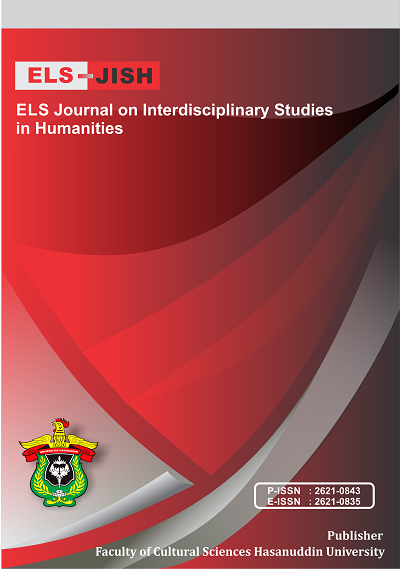Machine Translation: Source-Oriented and Target-Oriented Approaches
DOI:
https://doi.org/10.34050/elsjish.v5i4.24015Keywords:
English-Indonesian, Instagram Caption, Source-Oriented, Target-Oriented, Machine TranslationAbstract
Machine translation has become one of the important features in social media especially on Instagram. This case study investigates the English-Indonesian translations of sentences as the caption on Instagram, as well as analyses the source-oriented and target-oriented translations shown by the target language structures and styles. The frequency of occurrence is also calculated in order to analyze the different parts of sentences that are translated by applying source-oriented and target-oriented approaches. The data were collected from an Instagram account that has a long caption consisting twenty-nine sentences and also one phrase in English and their translations in Indonesian. The data were classified into the language expressions types and then analyzed based on the source-oriented and target-oriented translation approaches (Toury, 1980, 2012). The results show that there are three types of language expressions, they are common expressions, idiom, and phrasal verbs. In terms of the frequency of occurrence, 62% of all parts of sentences are translated based on the target-oriented approach. It reveals that the TL is good enough for the target readers to understand the messages and meanings of the original language. The common expressions are the most frequent parts of sentences that are translated based on the target-oriented approach. Idiom and phrasal verbs do not represent the analyzed data to draw the conclusion as there are only one idiom and four phrasal verbs out of twenty-six data (19%) found.
Keywords: source-oriented, target-oriented, machine translation, English-Indonesian, Instagram caption
References
Catford, J. C. (1965). A linguistic theory of translation. Oxford: Oxford University Press.
Gabriela Saldanha & Sharon O’Brien. (2014). Research methodologies in translation studies. New York: Routledge.
Hutchins, W. John. (1995). Machine translation: a brief history. In Koerner, E. F. K. and Asher, R. E. Concise history of the language sciences: from the Sumerians to the cognitivists (431-445). Oxford: Pergamon Press.
Irfan, Muhammad. (2017). Machine Translation. Retrieved from https://www.researchgate.net/publication/320730405
Larassati, Anisa et al. (2019). Google vs. Instagram Machine Translation: Multilingual application program interface errors in translating procedure text genre. International Seminar on Application for Technology of Information and Communication (554-558).
McCormick, Rich. (2016). Instagram is adding automatic in-app text translation. Retrieved from https://www.theverge.com/2016/6/23/12011008/instagram-text-translation-comments-in-app
Newmark, Peter. (1981). Approaches to translation. Oxford: Pergamon Press.
Nida, Eugene A. & Taber, Charles. (1982). The theory and practice of translation. Leiden: The Netherlands.
Okpor, M.D. (2014). Machine Translation Approaches: Issues and Challenges. IJCSI International Journal of Computer Science Issues, Vol. 11, Issue 5, No 2, September 2014 ISSN (Print): 1694-0814 | ISSN (Online): 1694-0784 www.IJCSI.org
Ponomareva, K. (2021). Source-oriented and Target-oriented dilemmas in translating the Harry Potter book series into Russian. Retrieved from https://surface.syr.edu/cgi/viewcontent.cgi?article=1183&context=eli
Rahman, F. (2017, December). Literary Translation and Cultural Transformation. In Conference: The 2nd Annual Seminar on English Language Studies at: Aula Mattulada FIB UNHAS, Makassar-IndonesiaVolume (Vol. 1).
Rahman, F. F., & Rahman, F. (2020). Translation or Intertextuality: A Literature Comparative Analysis of “The Young Dead Soldiers Do Not Speak” by Archibald MacLeish and “Krawang Bekasi” by Chairil Anwar. Elsya : Journal of English Language Studies, 1(3), 110-117. https://doi.org/10.31849/elsya.v1i3.5320
Sitsanis, Nikolaos. (2018). 5 Reasons Why Machine Translations Will Never Replace Human Translators. Retrieved from https://speakt.com/5-reasons-machine-translations-will-never-replace-human-translators/
Susanti, Eris. (2018). Lexical Errors Produced by Instagram Machine Translation. A Thesis. Malang: Univeritas Islam Negeri Maulana Malik Ibrahim.
Toury, Gideon. (1980). In search of a theory of translation. Porter Institute for Poetics and Semiotics, Tel Aviv University.
Toury, Gideon. (2012). Descriptive translation studies and beyond (2nd expanded ed.) Amsterdam / Philadelphia: John Benjamins Publishing Company.
Widiastuti, Ni Made Ayu. (2021). Translation Procedures of English Phrasal Verbs into Indonesian on Instagram Captions. International Seminar on Austronesian Languages and Literature IX (399-408). Denpasar: Udayana University.
Downloads
Published
How to Cite
Issue
Section
License
Copyright (c) 2022 Ni Made Ayu Widiastuti, Ni Ketut Sri Rahayuni

This work is licensed under a Creative Commons Attribution-NonCommercial-ShareAlike 4.0 International License.






